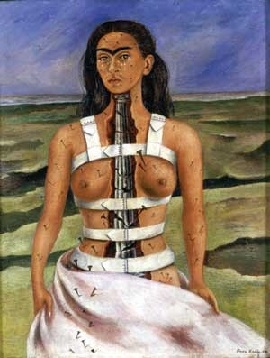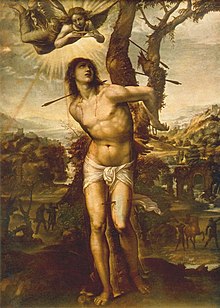| The Broken Column | |
|---|---|
| Spanish: La Columna Rota | |
 | |
| Artist | Frida Kahlo |
| Year | 1944 |
| Type | Oil on masonite |
| Dimensions | 39.8 cm× 30.6 cm(15.7 in× 12.0 in) |
| Location | Museo Dolores Olmedo, Xochimilco, Mexico City, Mexico |
The Broken Column (La Columna Rota in Spanish) is an oil on masonite painting by Mexican artist Frida Kahlo, painted in 1944 shortly after she had spinal surgery to correct on-going problems which had resulted from a serious traffic accident when she was 18 years old. The original is housed at the Museo Dolores Olmedo in Xochimilco, Mexico City, Mexico. [1]
Contents
As with many of her self-portraits, pain and suffering is the focus of the work, [2] though unlike many of her other works, which include parrots, dogs, monkeys and other people, [3] in this painting, Kahlo is alone. Her solitary presence on a cracked and barren landscape symbolizes both her isolation [2] and the external forces which have impacted her life. As an earthquake might fissure the landscape, Kahlo's accident broke her body. [4]
In the painting Kahlo's nude torso is split, replicating the ravine-laced earth behind her and revealing a crumbling, Ionic column in place of her spine. Her face looks forward, unflinchingly, though tears course down her cheeks. In spite of the brokenness of her internal body, her external sensuality is unmarred. The cloth which wraps the lower part of her body and is grasped in her hands, is not a sign of modesty [4] but instead mirrors the Christian iconography of Christ's sheet, as do the nails which are piercing her face and body. [5] The nails continue down only her right leg which was left shorter and weaker from contracting polio as a young child.
The metal corset, which depicts a polio support, rather than a surgical support, [6] may refer to her history of polio [3] or symbolize the physical and social restrictions of Kahlo's life. [4] By 1944, Kahlo's doctors had recommended that she wear a steel corset instead of the plaster casts she had worn previously. The brace depicted is one of many that Frida actually used throughout her life time and is now housed in her home and museum, Casa Azul. [7] In The Broken Column this corset holds together Kahlo's damaged body. [5] [8] [9]
